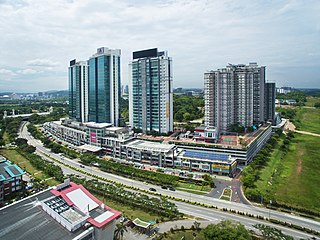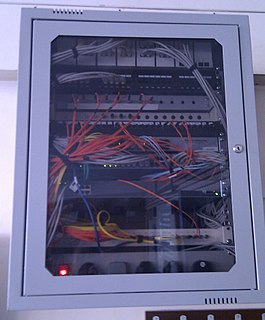
A metropolitan area network (MAN) is a computer network that interconnects users with computer resources in a geographic region of the size of a metropolitan area. The term MAN is applied to the interconnection of local area networks (LANs) in a city into a single larger network which may then also offer efficient connection to a wide area network. The term is also used to describe the interconnection of several local area networks in a metropolitan area through the use of point-to-point connections between them.

Kuala Lumpur International Airport (KLIA), is Malaysia's main international airport and one of the biggest airports in Southeast Asia and worldwide. It is located in Sepang District of Selangor, approximately 45 kilometres (28 mi) south of Kuala Lumpur city centre and serves the Greater Klang Valley conurbation.

Cyberjaya is a city with a science park as the core that forms a key part of the Multimedia Super Corridor in Malaysia. It is located in Sepang District, Selangor. Cyberjaya is adjacent to, and developed along with Putrajaya, Malaysia's government seat. This city aspires to be known as the Silicon Valley of Malaysia.

Telekom Malaysia Berhad (TM) is a Malaysian telecommunications company founded in 1984. Beginning as the national telecommunications company for fixed line, radio and television broadcasting services, it has evolved to become the country's largest provider of broadband services, data, fixed-line, pay television and network services. TM ventured into the Long Term Evolution (LTE) space with the launch of TMgo, its first 4G offering. TM's 850 MHz service was rebranded as unifi Mobile in January 2018.
The ideal telecommunication network has the following characteristics: broadband, multi-media, multi-point, multi-rate and economical implementation for a diversity of services (multi-services). The Broadband Integrated Services Digital Network (B-ISDN) was planned to provide these characteristics. Asynchronous Transfer Mode (ATM) was promoted as a target technology for meeting these requirements.
Putrajaya–Cyberjaya Expressway, Federal Route 29, is a major expressway in Klang Valley, Malaysia. It is the first future federal highway on the Multimedia Super Corridor (MSC) area. The 21.2 km (13.2 mi) expressway connects Serdang interchange on Damansara–Puchong Expressway to Kuala Lumpur International Airport (KLIA) in Sepang. It was named after the two sides of the MSC cities, Putrajaya and Cyberjaya.
The Maju Expressway (MEX) is an expressway network in Klang Valley, Malaysia. The 26 km (16 mi)-long expressway links the Kuala Lumpur City Centre with the Kuala Lumpur International Airport (KLIA) in Sepang, Selangor. The expressway is a backbone of the Multimedia Super Corridor (MSC) area.

Wateen Telecom is a converged communication services provider based in Lahore, Pakistan, and was (previously) a sister concern of Warid Telecom. The company was incorporated in 2005 and began its operations in 2007 with the deployment of the largest fibre optic network in the country. Moreover, Wateen is the world’s first company to commercially roll out a WiMAX network on a nationwide scale.
Distributed temperature sensing systems (DTS) are optoelectronic devices which measure temperatures by means of optical fibres functioning as linear sensors. Temperatures are recorded along the optical sensor cable, thus not at points, but as a continuous profile. A high accuracy of temperature determination is achieved over great distances. Typically the DTS systems can locate the temperature to a spatial resolution of 1 m with accuracy to within ±1°C at a resolution of 0.01°C. Measurement distances of greater than 30 km can be monitored and some specialised systems can provide even tighter spatial resolutions.

Fiber-optic communication is a method of transmitting information from one place to another by sending pulses of infrared light through an optical fiber. The light is a form of carrier wave that is modulated to carry information. Fiber is preferred over electrical cabling when high bandwidth, long distance, or immunity to electromagnetic interference is required. This type of communication can transmit voice, video, and telemetry through local area networks or across long distances.
Transportation in the Klang Valley, which includes Kuala Lumpur – the capital city of Malaysia – consists of highly-developed intermodal infrastructure. This includes an extensive road network, an integrated railway network, airports, and other modes of public transport. The Klang Valley is an urban conglomeration consisting of the city of Kuala Lumpur, as well as surrounding towns and cities in the state of Selangor. The Klang Valley has the country's largest airport, the Kuala Lumpur International Airport (KLIA), as well as the country's largest intermodal transport hub and railway station, Kuala Lumpur Sentral.

Bandar Bukit Tinggi is an integrated and modern township in Klang, Selangor, Malaysia. The RM5 billion self-sufficient mature township has a wide range of facilities and amenities.

Malaysia Airports Holdings Berhad is a Malaysian airport company that manages most of the airports in Malaysia. The firm was recently awarded the duty to manage airports in international destinations. It has its head office in the Malaysia Airports Corporate Office in the Persiaran Korporat KLIA in Kuala Lumpur International Airport (KLIA), Sepang, Selangor.
The operations and infrastructure of Kuala Lumpur International Airport reflect its design.
BharatNet, also known as Bharat Broadband Network Limited, is a government-owned broadband infrastructure provider, set up by the Department of Telecommunications, a department under Ministry of Communications of the Government of India for the establishment, management, and operation of the National Optical Fibre Network to provide a minimum of 100 Mbit/s broadband connectivity to all 250,000-gram panchayats in the country, covering nearly 625,000 villages, by improving the middle layer of nation-wide broadband internet in India to achieve the goal of Digital India.

Tempora is the codeword for a formerly-secret computer system that is used by the British Government Communications Headquarters (GCHQ). This system is used to buffer most Internet communications that are extracted from fibre-optic cables, so these can be processed and searched at a later time. It was tested from 2008 and became operational in late 2011.
ISO/IEC JTC 1/SC 25 Interconnection of information technology equipment is a standardization subcommittee of the Joint Technical Committee ISO/IEC JTC 1, of the International Organization for Standardization (ISO) and the International Electrotechnical Commission (IEC), which develops and facilitates standards within the field of interconnection of information technology equipment. The international secretariat of ISO/IEC JTC 1/SC 25 is the Deutsches Institut für Normung (DIN) located in Germany.

Fiber to the office (FTTO) is an alternative cabling concept for local area network (LAN) network office environments. It combines passive elements and active mini-switches to provide end devices with Gigabit Ethernet. FTTO involves centralised optical fibre cabling techniques to create a combined backbone/horizontal channel; this channel is provided from the work areas to the centralised cross-connect or interconnect by allowing the use of pull-through cables or splices in the telecommunications room.
The Iris Digital Communications System, also known as the Tactical Command, Control, and Communications System (TCCCS), is a tactical communication system used by the Canadian Army. It was a pioneering system that integrated voice and data communications via the Internet Protocol and ST-II protocol. Elements of the Iris system, together with the High-capacity data radio, later formed the foundation of the British Army's Bowman communications system.










